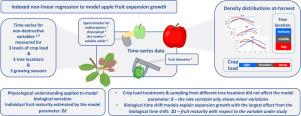Physiology at work to model apple expansion growth and skin pigment changes
IF 8.9
1区 农林科学
Q1 AGRICULTURE, MULTIDISCIPLINARY
引用次数: 0
Abstract
Fruit sizing is a major factor in determining yield while non-destructive monitoring of the fruit skin colour and internal quality attributes on the tree can provide valuable maturity and quality information for precision horticulture. Repeated spectral scanning and fruit sizing data of ‘Braeburn’ apples were collected on the tree from about 60 days after flowering until harvest. Assessed variables were: fruit diameter, dry matter (DMC), soluble solids content (SSC), a normalised difference vegetation index (NDVI) and a normalised anthocyanin index (NAI) analysed using indexed non-linear regression based on an adapted von Bertalanffy model (diameter, DMC, SSC), or a logistic model (NDVI, NAI). The reaction rate constants in the models were estimated in common for all fruit in a selection, while the biological shift factors (t) estimated the development stage or fruit maturity per individual fruit. Explained parts (R2adj) range from 85 to 97%. Tree location or crop load treatment only minimally affected the rate constants but did affect the estimated t values that describe almost all variation in the data. There is a close relationship between the t values for diameter, DMC and SSC but less with those of NDVI and almost none with the NAI. These data support the assumption that there is only one stage of fruit maturity, but it is estimated slightly differently depending on the measured variable. The actual relative growth rate strongly depends on the current size. Understanding apple expansion growth will therefore require a closer focus on the cell production period.

生理学在模拟苹果的扩张生长和皮肤色素的变化
果实的大小是决定产量的主要因素,而对果树果皮颜色和内部品质属性的无损监测可以为精准园艺提供有价值的成熟度和品质信息。从开花后约60天到收获,在树上收集了“Braeburn”苹果的重复光谱扫描和果实大小数据。评估变量为:果实直径、干物质(DMC)、可溶性固形物含量(SSC)、归一化植被差异指数(NDVI)和归一化花青素指数(NAI),采用指数非线性回归分析,基于自适应的von Bertalanffy模型(直径、DMC、SSC)或logistic模型(NDVI、NAI)。模型中的反应速率常数是对一个选择中的所有果实进行共同估计的,而生物位移因子(Δt)估计每个果实的发育阶段或果实成熟度。解释部分(R2adj)范围从85%到97%。树木位置或作物负荷处理对速率常数的影响最小,但确实影响了描述数据中几乎所有变化的Δt估计值。直径、DMC和SSC的Δt值与NDVI的关系不大,与NAI的关系几乎没有。这些数据支持水果成熟只有一个阶段的假设,但根据测量变量的不同,估计结果略有不同。实际的相对增长率很大程度上取决于当前的规模。因此,理解苹果的扩张生长需要更密切地关注细胞生产时期。
本文章由计算机程序翻译,如有差异,请以英文原文为准。
求助全文
约1分钟内获得全文
求助全文
来源期刊

Computers and Electronics in Agriculture
工程技术-计算机:跨学科应用
CiteScore
15.30
自引率
14.50%
发文量
800
审稿时长
62 days
期刊介绍:
Computers and Electronics in Agriculture provides international coverage of advancements in computer hardware, software, electronic instrumentation, and control systems applied to agricultural challenges. Encompassing agronomy, horticulture, forestry, aquaculture, and animal farming, the journal publishes original papers, reviews, and applications notes. It explores the use of computers and electronics in plant or animal agricultural production, covering topics like agricultural soils, water, pests, controlled environments, and waste. The scope extends to on-farm post-harvest operations and relevant technologies, including artificial intelligence, sensors, machine vision, robotics, networking, and simulation modeling. Its companion journal, Smart Agricultural Technology, continues the focus on smart applications in production agriculture.
 求助内容:
求助内容: 应助结果提醒方式:
应助结果提醒方式:


